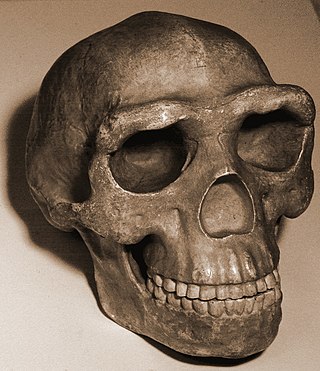Related Research Articles

Davidson Black, was a Canadian paleoanthropologist, best known for his naming of Sinanthropus pekinensis. He was Chairman of the Geological Survey of China and a Fellow of the Royal Society. He was known as 步達生 in China.

Peking Man is a subspecies of H. erectus which inhabited what is now northern China during the Middle Pleistocene. Its fossils have been found in a cave some 50 km (31 mi) southwest of Beijing, known as the Zhoukoudian Peking Man Site. The first fossil, a tooth, was discovered in 1921, and Zhoukoudian has since become the most productive H. erectus site in the world. Peking Man was instrumental in the foundation of Chinese anthropology, and fostered an important dialogue between Western and Eastern science. Peking Man became the centre of anthropological discussion, and was classified as a direct human ancestor, propping up the Out of Asia theory that humans evolved in Asia.
Below are notable events in archaeology that occurred in 1937.
Below are notable events in archaeology that occurred in 1926.

Zhoukoudian Peking Man Site (周口店北京人遗址), also romanized as Choukoutien, is a cave system in suburban Fangshan District, Beijing. It has yielded many archaeological discoveries, including one of the first specimens of Homo erectus, dubbed Peking Man, and a fine assemblage of bones of the giant short-faced hyena Pachycrocuta brevirostris.

Johan Gunnar Andersson was a Swedish archaeologist, geomorphologist, and paleontologist who was closely associated with the beginnings of Chinese archaeology in the 1920s.
Below are notable events in archaeology that occurred in 1931.
Below are notable events in archaeology that occurred in 1923.
This page lists major events of 2001 in archaeology.
Below are notable events in archaeology that occurred in 1941.
Below are notable events in archaeology that occurred in 1921.
Below are notable events in archaeology that occurred in 1949.
Below are notable events in archaeology that occurred in 1927.
Below are notable events in archaeology that occurred in 1929.
Below are notable events in archaeology that occurred in 1935.
Below are notable events in archaeology that occurred in 1930.

Pei Wenzhong, or W. C. Pei, was a Chinese paleontologist, archaeologist and anthropologist born in Fengnan. He is considered a founding figure of Chinese anthropology.

Jia Lanpo was a Chinese palaeoanthropologist, considered a founder of Chinese anthropology.
The Cenozoic Research Laboratory of the Geological Survey of China was established within the Peking Union Medical College in 1928 by Canadian paleoanthropologist Davidson Black and Chinese geologists Ding Wenjing and Weng Wenhao for the research and appraisal of Peking Man fossils unearthed at Zhoukoudian.
Margaret Eleanor Barbour Simpson, was a Scottish archaeologist. She is considered as the first professional woman archaeologist in Scotland. She was a member of V. Gordon Childe's team of archaeologists at Skara Brae and Kindrochat, as well as the writer of some of the first guidebooks for state-owned historic properties in Scotland.
References
- ↑ Péquart, M.; Péquart, S.-J.; Boule, M.; Vallois, H. (1937). Téviec, station nécropole mésolithique du Morbihan. Mémoire 18. Paris: Archives de l'Institut de Paléontologie Humaine.
- ↑ Schippmann, K. (1980). "Ktesiphon-Expedition im Winter 1928/29". Grundzüge der parthischen Geschichte. Darmstadt.
- ↑ Meyer, E. (1929). "Seleukia und Ktesiphon". Mitteilungen der Deutschen Orient-Gesellschaft zu Berlin. 67: 1–26.
- ↑ Reuther, O. (1929). "The German Excavations at Ctesiphon". Antiquity . 3 (12): 434–451. doi:10.1017/S0003598X00003781. S2CID 163969599.
- ↑ Upton, J. (1932). "The Expedition to Ctesiphon 1931–1932". Bulletin of the Metropolitan Museum of Art. 27 (8): 188–197. doi:10.2307/3255274. JSTOR 3255274.
- ↑ Fowler, Peter (8 May 2016). "Charles Thomas obituary". The Guardian . London. Retrieved 25 August 2017.
- ↑ "Margaret Rule obituary". The Guardian. Retrieved 17 May 2017.
- ↑ Tutankhamun's Curse?, Published in History Today Volume 64 Issue 3 March 2014